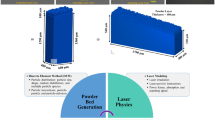Abstract
Fully dense freeform fabrication (FDFF) is a process based on thin line cutting processes, variable thickness layering, slicing in different orientations, and bulk layer attachment. The combination of these capabilities enables the production of good quality complex parts from practically any material at a very fast pace. As for rapid prototypes fabricated by the FDFF process, it is certainly possible to employ adaptive slicing technique due to the possibility of cutting different metal/non-metal sheet at various thicknesses. This paper proposes a new adaptive slicing method whereby the capability of cutting a 3D solid model at the predefined sheets’ thicknesses is achieved and the geometry of all internal and external features of a part is also investigated to ensure the reduction of part geometry deviation through the seamless curvature detection. Despite most previous works which start slicing a tessellated or direct CAD model at the maximum available thickness, this system commences the process with available minimum thickness by applying a new adaptive method to all pairs of contours at the top and bottom slices of the layer. Autodesk Inventor solid modeler, as a design-by-feature solid modeler, is used for 3D solid modeling. The proposed system is implemented by Visual Basic codes inside Inventor using API functions to access both geometry and topology information of the design-by-feature solid model. This system has been successfully tested on a variety of complex parts containing sophisticated internal and external features.
Similar content being viewed by others
References
Ameri, F., McArthur, C., Asiabanpour, B., & Hayasi, M. (2011). A web-based framework for semantic supplier discovery for discrete part manufacturing. SME/NAMRC 39 Transaction.
Asiabanpour, B., & Khoshnevis, B. (2003). A new memory efficient tool path generation method for applying very large STL files in vector-by-vector rapid prototyping processes. Computer and Industrial Engineering, San Francisco, CA.
Asiabanpour B., Khoshnevis B. (2004) Machine path generation for the SIS process. Robotics and Computer-Integrated Manufacturing 20: 167–175
Chang C. C. (2004) Direct slicing and G-code contour for rapid prototyping machine of UV resin spray using PowerSOLUTION macro commands. International Journal of Advanced Manufacturing Technology 23(5–6): 358–365
Chen X., Wang C., Ye X., Xiao Y., Huang S. (2001) Direct slicing from PowerSHAPE models for rapid prototyping. International Journal of Advanced Manufacturing Technology 17(7): 543–547
Choi, S. H., & Kwok, K. T. (1999). A memory efficient slicing algorithm for large STL file. Paper presented at the Solid Freeform Fabrication Symposium, Austin, Texas.
Chua C. K., Gan J. G. K., Tong M. (1997) Interface between CAD and rapid prototyping systems. 1. A study of existing interfaces. International Journal of Advanced Manufacturing Technology 13(8): 566–570
Chua C. K., Gan J. G. K., Tong M. (1997) Interface between CAD and Rapid Prototyping systems. 2. LMI: An improved interface. International Journal of Advanced Manufacturing Technology 13(8): 571–576
Cormier D., Unnanon K., Sanii E. (2000) Specifying non-uniform cusp heights as a potential aid for adaptive slicing. Rapid Prototyping Journal 6(3): 204–211
Dolenc A., Makela I. (1994) Slicing procedures for layered manufacturing techniques. Computer-Aided Design 26(2): 119–126
Hayasi M. T., Asiabanpour B. (2009) Machine path generation using direct slicing from design-by-feature solid model for rapid prototyping. International Journal of Advanced Manufacturing Technology 45(1–2): 170–180
Hayasi, M. T., & Asiabanpour, B. (2010). Adaptive layering technique for the fully dense freeform fabrication (FDFF) process. Paper presented at the Second International Research Conference for Graduate Students, Texas State University-San Marcos.
Jamieson R., Hacker H. (1995) Direct slicing of CAD models for rapid prototyping. Rapid Prototyping Journal 1(2): 4–12
Jung J. Y., Ahluwalia R. S. (2005) NC tool path generation for 5-axis machining of free formed surfaces. Journal of Intelligent Manufacturing 16(1): 115–127
Jurrens K. K. (1999) Standards for the rapid prototyping in industry. Rapid Prototyping Journal 5(4): 169–178
Koc B., Ma Y. W., Lee Y. S. (2000) Smoothing STL files by Max-Fit biarc curves for rapid prototyping. Rapid Prototyping Journal 6(3): 186–203
Kulkarni P., Dutta D. (1996) An accurate slicing procedure for layered manufacturing. Computer-Aided Design 28(9): 683–697
Kumar C., Choudhury A. R. (2005) Volume deviation in direct slicing. Rapid Prototyping Journal 11(3): 174–184
Onuh S. O., Yusuf Y. Y. (1999) Rapid prototyping technology: Applications and benefits for rapid product development. Journal of Intelligent Manufacturing 10: 301–311
Pande S. S., Kumar S. (2008) A generative process planning system for parts produced by rapid prototyping. International Journal of Production Research 46(22): 6431–6460
Pandey P. M., Reddy N. V., Dhande S. G. (2003) Real time adaptive slicing for fused deposition modelling. International Journal of Machine Tools & Manufacture 43(1): 61–71
Singhal S. K., Prashant K. J., Pulak M. P. (2008) Adaptive Slicing for SLS Prototyping. Computer-Aided Design and Applications 5(1–4): 421–423
Susila B., Gunasekaran A., Arunachalam S., Padhakrishnan P. (1999) Interfacing geometric model data with rapid prototyping systems. Journal of Intelligent Manufacturing 10: 323–329
Tyberg J., Bohn J. H. (1998) Local adaptive slicing. Rapid Prototyping Journal 4(3): 118–127
Vouzelaud, T., & Bagchi, A. (1995). An adaptive lamina generation for shape dependent process control and/or object decomposition. Patent number: 5,432,704.
Vuyyuru, P., Kirschman, C. F., Fadel, G., Bagchi, A., & Jara, C. C. (1994). A NURBS-based approach for rapid product realization. Paper presented at the Proceedings of the 5th International Conference on Rapid Prototyping, The University of Dayton.
Xu F., Wong Y. S., Loh H. T., Fuh J. Y. H., Miyazawa T. (1997) Optimal orientation with variable slicing in stereolithography. Rapid Prototyping Journal 3(3): 76–88
Zhao Z. W., Laperriere L. (2000) Adaptive direct slicing of the solid model for rapid prototyping. International Journal of Production Research 38(1): 69–83
Author information
Authors and Affiliations
Corresponding author
Rights and permissions
About this article
Cite this article
Hayasi, M.T., Asiabanpour, B. A new adaptive slicing approach for the fully dense freeform fabrication (FDFF) process. J Intell Manuf 24, 683–694 (2013). https://doi.org/10.1007/s10845-011-0615-4
Received:
Accepted:
Published:
Issue Date:
DOI: https://doi.org/10.1007/s10845-011-0615-4




